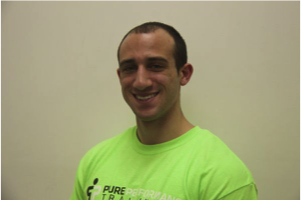As this post goes live I’m (hopefully) en route back to Boston after attending Mark Fisher’s wedding in NYC this past weekend. I decided it best to pre-schedule something on the off-chance some crazy shenanigans went down, like, I don’t know, an impromptu dance-off with a unicorn or a shot of Tequila somehow made it into my hands.
Nevertheless, better safe than sorry…I needed to plan a head.
Today’s guest post comes courtesy of Boston-based strength coach and massage therapist, Mike Sirani.
Enjoy!

Oh, the assessment.
The assessment is one of the most pivotal moments when working as a personal trainer or strength and conditioning coach. It’s often your first in-person interaction with a potential client.
Even though brand awareness, marketing, and your reputation can all help your chances of success before the assessment even starts, you still have 30 to 90 minutes to sell a client on why you or your gym is the best person/place to help them reach their goals.
This can be difficult, especially if:
- You’re young and/or new to training people.
- You feel like you’re not as busy as you should be.
- You have thoughts like, “I’m so much smarter than this other trainer, but they’re making way more money than me.”
- You often scratch your head thinking things like, “I’ve taken PRI, DNS, FMS, FRC, SFG, and eat KFC, and despite all of my continuing education, the number of clients I see still isn’t growing.
If any of the above rings a bell to you, I believe this article can help you.
All the knowledge in the world is as useless as the Cleveland Browns on a Sunday unless you understand a few key things.
1) Most People Are Seeking Your Services to Get Fit
Somewhere along the way, physical therapy blurred with strength and conditioning, and strength and conditioning blended with physical therapy. It’s great for the field, and both do work optimally together, along the same continuum, but it’s important to know your role.
Most clients looking to improve their fitness don’t give a shit about their pelvic inlet position or posterior mediastinum’s or the 10-degree difference in hip internal rotation from side to side. When you start throwing out those terms, you’re just a big weirdo. Here’s what I recommend instead:
Listen
- Be an active listener.
- Have good body language.
- Ask the right questions. All of your questions should help you build rapport and lead towards making good clinical decisions in order to help the person in front of you.
Meet Them Where They’re At
- Don’t put down or talk bad about someone’s previous exercise programs, especially if it’s something they enjoy doing.
- Making them stop doing something they enjoy should be your last option and done only if you’re 100% sure it’s holding them back from reaching their goals.
- People will have pre-conceived notions and it’s your job to educated them—but also respect their views and understand that not everyone will be a good fit to work with you.
- I currently train clients who are yogis, cyclists, triathletes, Cross Fitters, Pilate’s enthusiasts, and runners. What do they all have in common? They see value in my service, enough to limit how much they’re doing of their other activities to make room for strength training because it will help them reach their goals and allow them to continue doing the activities they love
Actually Come Up with a Fitness Plan
- Here’s an idea: Instead of throwing someone through the gamut of corrective exercises on Day 1, why don’t you bring them through a brief workout?
- Show them what they’re good at, show them what they’re bad at, and actually coach them through different movements.
- Then work with them to come up with the outline of a plan that you’ll use to guide them towards reaching their goals.
2) Context Matters!
It’s clear that above I poked fun at a few philosophies and anatomical terms. Please don’t get me wrong. I don’t condone being one of those trainers who is all about doing an exercise only because it looks cool and fun. The better you know your anatomy, physiology, biomechanics, and pain science, the more potential you’ll have to be a great coach.
wrong. I don’t condone being one of those trainers who is all about doing an exercise only because it looks cool and fun. The better you know your anatomy, physiology, biomechanics, and pain science, the more potential you’ll have to be a great coach.
But, as a coach, you must also take all of that knowledge and put it in CONTEXT for the client to UNDERSTAND, APPRECIATE, and VALUE what you are saying.
You see, we take these continuing education courses that are catered towards physical therapists, massage therapists, and chiropractors and think we can explain things the same way when bringing someone through a fitness evaluation. Often times in a course, you’re explaining that increasing this range of motion or decreasing tissue tension in this area will help alleviate pain.
What if your client isn’t in any pain and they just want to get fit? What do you do then?
Consider learning how to re-phrase things and put them into context that not only work for fitness and performance, but put value in what you can do to help them reach their goals. Here are a few examples:
- A right-handed baseball player who lacks passive hip internal rotation – “When we increase your hip internal rotation, you’ll be able to load and explode much better with your lower body and generate a lot more power during your swing.”
- A powerlifter who lacks ankle dorsiflexion – “When we increase your dorsiflexion, it’ll become much easier to hit depth on your squat and you won’t get red-lighted on weights you should be able to lift.”
- A client who asks why you’re watching them perform certain movements during a FMS – “This will give us a better idea of what exercises will be best for you body at this time and tell us what you need to work on in order to progress the exercises you’ll be doing during your first program.”
With that being said, you also need to realize that you’ll run into situations where a client may have a Type A personality and want to know the details and the science. Now is the time when you can step up to the plate and impress the client with your knowledge of anatomy, physiology, and biomechanics.
3) Analogies
Science can get complicated. It can be overwhelming explaining tissue healing or specific training and rehab concepts to a client. This is where analogies can be huge for educating a client and getting them to buy in and be on the same page as you.
A good analogy is great for explaining an unfamiliar concept with a familiar one and can take complex explanations and make them simple.
Be creative with these and make sure you drive your point home with something your client really resonates with.
In Summary
If you’re good at your job and are able to get a client to train with you a couple times a week, you’ll likely have good adherence and get good results. But you have to first know how to put yourself in a situation where someone is willing to spend money on you or your gym each week. It’s easy to fail getting to this point when you get caught up in how much you think you know and are waiting for every opportunity to share what you learned over the weekend.
Instead of feeding into your own ego by showcasing your knowledge with a new client:
- Be a good listener
- Meet them where they’re at
- Always come up with a plan
- Know that context matters!
- Use analogies.
I once heard Alwyn Cosgrove say, “If you can see John Smith through John Smith’s eyes, you can sell John Smith what John Smith buys.”
If you can remember to see John Smith through John Smith’s eyes and know that clients don’t care how much you know until they know how much you care, you’ll be a much better coach, and your busier schedule and increase in clients/members will surely reflect your improvements.
About the Author
 Mike Sirani is a strength and conditioning coach and massage therapist in Boston, MA. He works at Pure Performance Training where he helps client’s look, feel, move, and perform better.
Mike Sirani is a strength and conditioning coach and massage therapist in Boston, MA. He works at Pure Performance Training where he helps client’s look, feel, move, and perform better.
Prior to building a successful personal training business in Boston, Mike graduated from one of the nation’s best exercise science programs at Springfield College and graduated from the Cortiva Institute in Boston for massage therapy shortly after.
He interned at Conca Sport and Fitness, one of Western Massachusetts’ top training facilities, and the nation’s best baseball strength and conditioning facility, Cressey Sports Performance. He is a certified strength and conditioning coach through the NSCA and has completed extensive continuing education in manual therapy, cardiovascular training, Functional Range Conditioning (FRC), Postural Restoration Institute (PRI), and Functional Movement Screen (FMS).
Mike played collegiate baseball at Springfield College and is an avid golfer. When not doing any of the above, Mike enjoys binging on good television shows and spending time with his fiancé. You can check out what Mike is up to on Facebook or check out some of his other articles at Rebel Performance.


